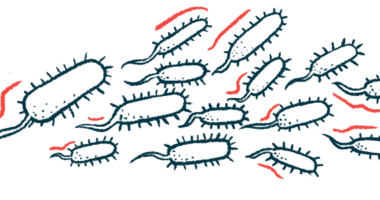Use of maintenance therapy in AAV not found to increase infection risk
Lower rate of serious infections seen with rituximab in new analysis

Maintenance therapy with immunosuppressive agents such as rituximab and azathioprine do not increase the frequency of serious infections beyond what’s expected in people with ANCA-associated vasculitis (AAV), according to a new review study.
Regardless of the medication used, fatal infections were uncommon during the maintenance therapy period, data show.
In addition, a lower rate of serious infections was reported among patients treated with rituximab for both induction and maintenance of remission compared with those given cyclophosphamide for remission induction and azathioprine for maintenance.
“Clinical practice with close monitoring of serious infections during prolonged follow-up are needed” to confirm these findings, the researchers wrote.
The review study, “Incidence of serious infections in patients with ANCA-associated vasculitis receiving immunosuppressive therapy: A systematic review and meta-analysis,” was published in the journal Frontiers in Medicine.
Infections among most common adverse outcomes in AAV patients
AAV comprises a group of autoimmune diseases characterized by inflammation and damage to small blood vessels. It’s caused by the excessive activation of certain cells of the immune system called neutrophils.
Several approved AAV treatments work by reducing the activity of the immune system to achieve remission and prevent relapse. Patients usually start with an induction treatment — higher doses of a medication to promote disease remission — followed by lower medication doses over time to maintain remission. Different medications can be used for the two treatment stages, or one therapy can be used for both.
Rituximab and azathioprine are immunosuppressive therapies commonly used to induce or maintain disease remission in people with AAV. Rituximab is sold as Rituxan in the U.S., MabThera in Europe, and also is available as biosimilars. Azathioprine, meanwhile, is sold as Imuran and others, with generics available.
“Infectious complications are some of the most common adverse outcomes in patients with AAV,” the researchers wrote. This is due to the disease process itself and as a result of immunosuppressive medications that increase susceptibility to infections.
A review study published in 2020 indicated that rituximab treatment, mainly during the induction period, was associated with a 15.4% rate of serious infections, which appeared to drop during follow-up.
“However, there is limited information regarding the risk for serious infection during the maintenance period compared to the induction period,” the researchers wrote.
Now, a team of scientists in the U.S. sought to evaluate the rates of serious infections and infection-related deaths during the maintenance period in AAV patients treated with either rituximab or azathioprine. To that end, the team retrospectively analyzed data from clinical trials and observational studies published up to Sept. 27, 2022.
A total of 21 studies on the incidence of serious infections during the maintenance period were included in the final meta-analysis, along with 13 studies on infection-related deaths or serious infections during the induction and maintenance periods (total follow-up). The included studies covered data from a total of 2,938 AAV patients.
The studies with available data for serious infection rates during the maintenance period included 1,284 patients, of whom 617 (48.1%) were treated with rituximab and 412 (32.1%) with azathioprine. The remaining patients were treated with methotrexate (16%) or mycophenolate mofetil (3.8%).
The overall incidence of serious infections during the maintenance period was 7.62%, with rituximab being associated with a 14.61% rate, and azathioprine with 5.93%. More than half (53%) of these serious infections involved the upper respiratory tract, particularly pneumonia.
Sepsis, or an extreme immune response to infection, was uncommon, although associated with high mortality.
Available data from 963 patients showed that the percentage of deaths among those who contracted an infection was 0.49%. Specifically, it was 1.29% among rituximab-treated patients, and 0.3% for those treated with azathioprine.
Fewer serious infections seen with rituximab maintenance therapy
Based on cause-of-death data from 1,460 patients, the team found that the infection-related mortality was very low during maintenance therapy (0.09%), ranging from 0.01% for patients treated with azathioprine to 1.01% for those who received rituximab.
Among 14 documented infection-related deaths, half of them were caused by respiratory infections, two of which were due to COVID-19 pneumonia, and six by sepsis.
The team then analyzed data from 814 patients with available data on serious infections during both the induction and maintenance periods, ranging from 1.5 years to nearly five years.
Results showed that the overall rate of serious infections during both periods was 15.99%.
Patients treated with rituximab for both induction and maintenance showed a lower serious infection rate than those given cyclophosphamide for induction and azathioprine for maintenance (14.12% vs. 20.81%).
Our analysis indicates that patients receiving a rituximab treatment scheme for both induction and maintenance did not experience an increase in serious infections throughout the treatment period compared to the reported incidences during induction of remission.
Similar results were obtained when the team looked only at data coming from appropriately-controlled clinical trials, further confirming their findings.
“Our analysis indicates that patients receiving a rituximab treatment scheme for both induction and maintenance did not experience an increase in serious infections throughout the treatment period compared to the reported incidences during induction of remission [15.40%],” the researchers wrote.
“The cumulative incidence of serious infections during total follow-up and maintenance was within expected limits, while fatal infections during maintenance treatment were uncommon,” the team wrote.
Overall, these results “substantiated the fact that available maintenance treatment agents have very low case fatality and infection-related mortality rates,” according to the team.
“Fatal infections are decreasing as newer immunosuppressive agents for maintenance are introduced,” the team wrote, adding that this may, however, be related also to the increased experience in the management of infectious complications among AAV patients.








